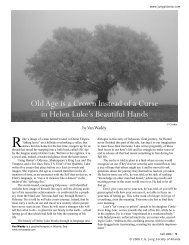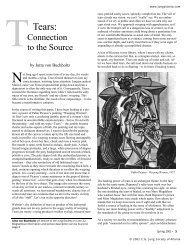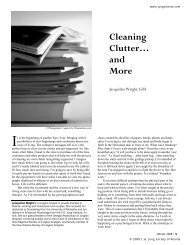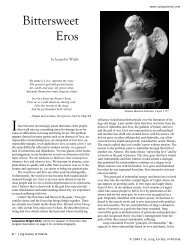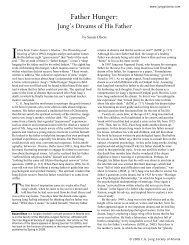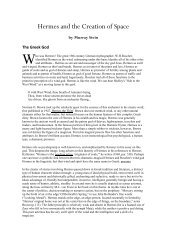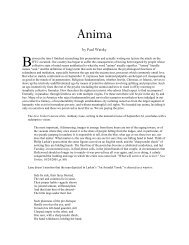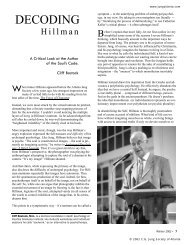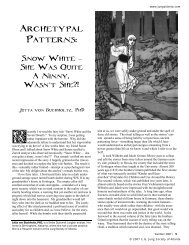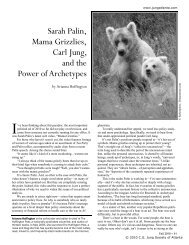Jung and Religion (Again) - C.G. Jung Society of Atlanta
Jung and Religion (Again) - C.G. Jung Society of Atlanta
Jung and Religion (Again) - C.G. Jung Society of Atlanta
Create successful ePaper yourself
Turn your PDF publications into a flip-book with our unique Google optimized e-Paper software.
<strong>Jung</strong> <strong>and</strong><br />
<strong>Religion</strong><br />
(<strong>Again</strong>)<br />
by William Willeford<br />
<strong>Jung</strong>ian Analyst<br />
T<br />
he C.G. <strong>Jung</strong> <strong>Society</strong> <strong>of</strong> <strong>Atlanta</strong> meets at Trinity Presbyterian<br />
Church, as it has in the past at other<br />
churches, <strong>and</strong> as similar groups do elsewhere. Some<br />
decades ago a bibliography was published <strong>of</strong> books <strong>and</strong> articles<br />
about <strong>Jung</strong> <strong>and</strong> religion; it listed over 500. If it were updated,<br />
it would now include several times that number. At the<br />
lower level <strong>of</strong> these writings, <strong>Jung</strong> is misrepresented as having<br />
tried to found a personal pseudo-religion (Richard Noll,<br />
The <strong>Jung</strong> Cult, 1994): indeed contentions that he was a mystic<br />
go back to the beginnings <strong>of</strong> his pr<strong>of</strong>essional career. At a<br />
higher level, many <strong>of</strong> these writings maintain or assume that<br />
in at least some measure <strong>and</strong> in some sense, not necessarily<br />
easy to define, psychology <strong>and</strong> religion inhabit overlapping<br />
<strong>and</strong> partly even identical domains.<br />
In a recent article the <strong>Jung</strong>ian psychoanalyst Ann Ulanov<br />
argues that there is a dimension <strong>of</strong> the psyche that dem<strong>and</strong>s<br />
what must be called a religious response (“Countertransference<br />
<strong>and</strong> the Self,” Journal <strong>of</strong> <strong>Jung</strong>ian Theory <strong>and</strong> Practice,<br />
Vol. 1, Fall, 1999). This dem<strong>and</strong> is strong enough that writers<br />
in many respects not far from the psychoanalytic mainstream<br />
have felt the need to adopt such words as ontological<br />
(Laing), sacred (Winnecott), prayer (Bollas) faith (Biou) <strong>and</strong><br />
resurrection <strong>of</strong> the body. Ulanov believes that it is important<br />
for an analyst to have a properly spiritual attitude, but she<br />
takes these authors to be not quite playing straight (if I may<br />
put it more crassly than she does) as they show no signs <strong>of</strong> a<br />
spiritual attitude that would grant the words their full meaning.<br />
What then is a proper spiritual attitude? She must think<br />
she has one, but, I ask myself, would she agree that I do also,<br />
or would she also think that I, too, fudge in the manner <strong>of</strong> the<br />
writers she listed?<br />
Years ago I sometimes taught a university course with the<br />
title “<strong>Religion</strong> <strong>and</strong> Personality.” In one incarnation <strong>of</strong> the<br />
course, we adopted as a guiding theme the question: how is<br />
religion to be distinguished from psychopathology, including<br />
out <strong>and</strong> out craziness? After all, a great many psychotic delu-<br />
sions are religious in character. It became clear to us, as I had<br />
suspected, that there are no clear <strong>and</strong> easy answers to such<br />
questions. By speaking <strong>of</strong> what he called the objective psyche,<br />
<strong>Jung</strong> attempted to overcome, or at least temper, the subjectivity<br />
that is an essential ingredient <strong>of</strong> religion. But the<br />
issues <strong>of</strong> how to talk psychologically about religious reality<br />
are subtle <strong>and</strong> persistent.<br />
A recent issue <strong>of</strong> the Journal <strong>of</strong> Analytical Psychology (44, 4.<br />
1999) includes a series <strong>of</strong> papers under the general heading<br />
“Is analytical psychology a religion? <strong>Jung</strong>’s search for a substitute<br />
for lost faith.” Note that rather than being put into a<br />
huff by the title, these authors sympathetic to <strong>Jung</strong> were<br />
ready to accept it as a basis for serious discussion. The title<br />
alone should remind us <strong>of</strong> ways in which the scientist <strong>Jung</strong>,<br />
the son <strong>and</strong> gr<strong>and</strong>son <strong>of</strong> clergymen, carried with him <strong>and</strong><br />
within him the nineteenth-century conflict between religion<br />
<strong>and</strong> science that we associate with Darwin, <strong>and</strong> made working<br />
at it a major theme <strong>of</strong> his psychology. I turn to these papers<br />
now because one <strong>of</strong> them, Robert A. Segal’s<br />
“Rationalist <strong>and</strong> romantic approaches to religion <strong>and</strong> modernity,”<br />
provides useful distinctions bearing on the matters I<br />
have been talking about. And it occurs to me that readers <strong>of</strong><br />
this newsletter might in their own ponderings find his way <strong>of</strong><br />
posing the issues helpful.<br />
F<br />
undamentalists for Segal accept religion as explanation—for<br />
example, <strong>of</strong> the way the physical world has<br />
come to be <strong>and</strong> <strong>of</strong> the structure it has. Rationalists like<br />
Freud <strong>and</strong> <strong>Jung</strong> are also modernists, unlike fundamentalists,<br />
in rejecting religious explanations in favor <strong>of</strong> scientific ones.<br />
But some modernists—like <strong>Jung</strong>, William James, Mircea<br />
Eliade <strong>and</strong> Joseph Campbell, but unlike Freud—are romantics<br />
in thinking that science <strong>and</strong> religion may be compatible if<br />
the explanatory aspect <strong>of</strong> religion is disregarded in favor <strong>of</strong><br />
others, such as that <strong>of</strong> providing symbols having psychological<br />
value. While both Freud <strong>and</strong> <strong>Jung</strong> view religion psychologically,<br />
Freud’s rejection <strong>of</strong> its explanatory aspect makes<br />
him condemn it, whereas this is not so for <strong>Jung</strong>. As Segal<br />
summarizes the matter: “<strong>Jung</strong> so relentlessly psychologizes…religion<br />
that religion replaced by psychology is religion<br />
as it has always been…. If religion has always been psychology<br />
<strong>and</strong> not explanation, then religion without explanation<br />
remains religion. That is why <strong>Jung</strong> can draw a straight<br />
line from Gnosticism to alchemy to [<strong>Jung</strong>’s] analytical psychology.”<br />
The latter has, however, separated out the questionable<br />
metaphysics <strong>of</strong> these predecessors from their valid<br />
psychology. “Taken in this way,” Segal concludes, <strong>Jung</strong> is a<br />
consummate romantic.”<br />
In using “romantic” in this way, Segal does not mean, as an<br />
ad for a movie or a novel might, that <strong>Jung</strong> is charmingly sentimental.<br />
Rather, though the romantics Segal cites are all<br />
from the twentieth century, he is aware that their spiritual<br />
heirs belonged to the Romantic Movement <strong>of</strong> the nineteenth<br />
century <strong>and</strong> included Coleridge, Shelley, Hugo <strong>and</strong> Novalis.<br />
These earlier figures countered the rationalism <strong>of</strong> the eighteenth<br />
century, which has persisted as a main component <strong>of</strong><br />
modern science, with a reverence for imagination as a source<br />
Quarterly News page 5
<strong>of</strong> truth. In this tradition <strong>Jung</strong> has been an important twentiethcentury<br />
explorer <strong>of</strong> religion as imaginative <strong>and</strong> also potentially<br />
true.<br />
In the words <strong>of</strong> William Blake two hundred years ago:<br />
The Atoms <strong>of</strong> Democritus<br />
And Newton’s Particles <strong>of</strong> light<br />
Are s<strong>and</strong>s upon the Red Sea shore,<br />
Where Israel’s tents do shine so bright.”<br />
No amount <strong>of</strong> rational <strong>and</strong> scientific analysis can reduce<br />
imaginative truth to mere fact. Whatever else it may be, what<br />
<strong>Jung</strong> called the reality <strong>of</strong> the psyche is imaginative, <strong>and</strong> religion<br />
is, as it has always been, one <strong>of</strong> its basic forms <strong>of</strong> expression.<br />
Still, these assertions which convince me, do not, in any<br />
simple way, answer the questions that I raised in connection<br />
with Ulanov, that hover at the edge <strong>of</strong> Segal’s argument, <strong>and</strong><br />
that had faced my students trying to distinguish between religion<br />
<strong>and</strong> psychopathology. And so the discussion continues,<br />
<strong>and</strong> so it will include more books <strong>and</strong> articles on <strong>Jung</strong> <strong>and</strong><br />
religion �<br />
William Willeford, Ph.D., is a <strong>Jung</strong>ian Analyst in private practice<br />
in <strong>Atlanta</strong>. He is a member <strong>of</strong> the Georgia Association <strong>of</strong><br />
<strong>Jung</strong>ian Analysts.<br />
PICTURING GOD<br />
by Wilson Elijah McCreary<br />
The Christian literalist's religion<br />
is a pr<strong>of</strong>usion <strong>of</strong> confusion.<br />
Jesus crucified, dead, <strong>and</strong> buried,<br />
arisen,<br />
ascended,<br />
now a picture on a wall,<br />
the Man, God<br />
preaching love,<br />
care for the afflicted,<br />
turning the other cheek<br />
Looks light skinned Caucasian.<br />
The beard <strong>and</strong> long hair though,<br />
a well kempt hippie.<br />
But never mind,<br />
we've made Him thoroughly<br />
into man's image.<br />
We've had trouble though<br />
putting him into the movies<br />
<strong>and</strong> on the stage.<br />
To me, a shadowy figure<br />
mentally a little strange,<br />
some would say<br />
emotionally out <strong>of</strong> balance,<br />
not like Moses.<br />
Charlton Heston did a hell <strong>of</strong> a job,<br />
didn't he?<br />
WORK<br />
by Wilson Elijah McCreary<br />
When I worked on mixing TV pictures<br />
with computer graphics,<br />
MultiMedia,<br />
a euphemism for<br />
"We can put inane TV images<br />
on the computer too,"<br />
I could watch any channel broadcast<br />
in the local area.<br />
I was drawn to the religious channels,<br />
The 700 Club,<br />
the Trinity Broadcast Network.<br />
It was a sleazy gaggle<br />
<strong>of</strong> wealthy beggars<br />
in thous<strong>and</strong> dollar suits<br />
<strong>and</strong> three hundred dollar shoes<br />
engaged in an unholy<br />
haranguing, singing, dancing,<br />
pissing contest<br />
vying for the poor widow woman's<br />
welfare check<br />
or, if you were wealthy<br />
a check for three<br />
or four hundred<br />
or maybe a few thous<strong>and</strong><br />
would be even much better.<br />
It's really a good deal.<br />
They give you the problem<br />
<strong>and</strong> the solution<br />
all in one package.<br />
The problem, <strong>of</strong> course,<br />
is that you need<br />
your ticket punched<br />
for Gabe <strong>and</strong> Saint Pete<br />
for entry through the pearly gates<br />
<strong>and</strong> you're unworthy,<br />
a nasty, sinful, worthless worm<br />
destined to be dust under God's s<strong>and</strong>als<br />
unless you pay attention <strong>and</strong> send<br />
money.<br />
The solution is near at h<strong>and</strong> as well<br />
Just send the money<br />
<strong>and</strong> your mailing address<br />
<strong>and</strong> they'll pray for you.<br />
Anything's possible.<br />
Quarterly News page 6




